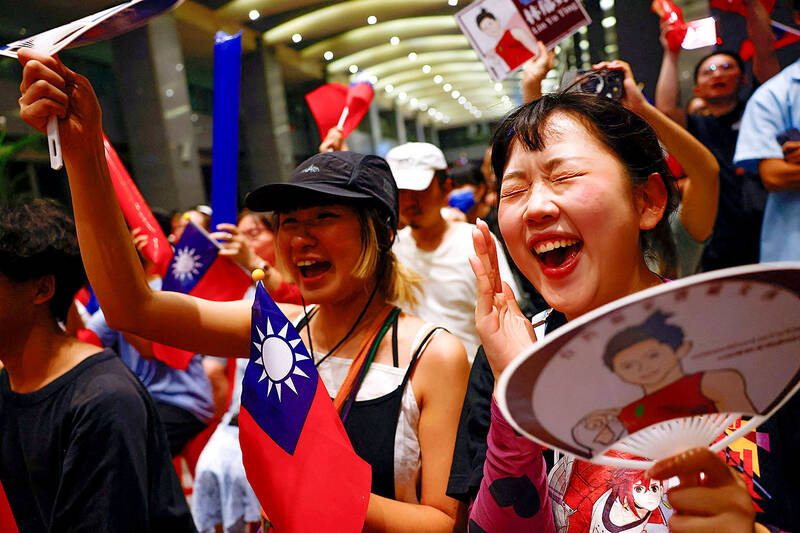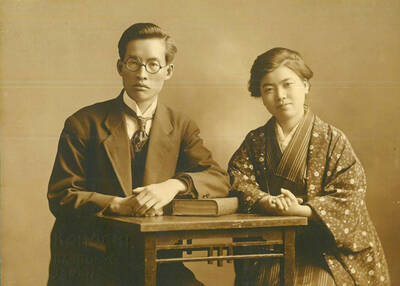Press conferences held by China’s Taiwan Affairs Office (TAO) are usually predictable affairs featuring attacks on Taiwan’s “[President William] Lai Ching-te (賴清德), leader of the Taiwan region,” “Taiwan’s Democratic Progressive Party (DPP) authority” and “stubborn secessionists” “going against the tide of history” and who are for some reason almost always “playing with fire.” The poor beset upon People’s Republic of China (PRC) has to put up with so much “provocation” by “Taiwan independence forces” at the behest of the US. Fun reading.
However, on July 24 TAO spokesperson Zhu Fenglian (朱鳳蓮) made some surprise moves. She was reacting to two recent, almost certainly connected moves in Taiwan just days apart that appear to have gotten under the Chinese Communist Party’s (CCP) skin.
One move was the Ministry of Education (MOE) announcing plans to change the labeling on language teaching materials from “Southern Min” (閩南語) to “Taiwan Taiwanese” (台灣台語). The other was President Lai’s decision to give his entire speech at the DPP National Congress in “Taiwan Taiwanese.”

Photo: Reuters
ZHU’S APPEALS TO ETHNONATIONALISM
At the TAO press conference, Zhu — who is Cantonese — made the case that Taiwanese and Hakka are mere “dialects” of Chinese, and that those languages being spoken in Taiwan are simply imported Chinese dialects and they are the same as those spoken in China.
Then to everyone’s surprise, she tried to make that case in both languages, or at least the versions spoken in China. This was a somewhat unexpectedly creative twist.

Photo: Reuters
Among other things, she said “that by deliberately differentiating the Chinese dialects used on the island of Taiwan from putonghua (普通話, standard Chinese), Taiwan’s Democratic Progressive Party (DPP) authority is staging a poor melodrama to push forward ‘de-Sinicization’ on the island.”
Aside from a very small number of people inclined to think this way already, it is highly unlikely that this line of argument from Beijing is going to make the slightest difference with the public in Taiwan. There is no doubt they are distinct languages, not “dialects,” as any language chart not produced by the CCP clearly shows.
The MOE’s “Taiwan Taiwanese” is a dialect of Southern Min, but it is mutually unintelligible with Mandarin and the two languages are at the opposite ends of the chart of Sinitic languages, with Hakka at the opposite end of the southern Sinitic languages as “Taiwan Taiwanese.” Mandarin is a northern Sinitic language, making it about as similar to the southern languages as Slavic or Romance languages with English.
There is a debate, and a lively one going on in the pages of this newspaper in recent days, on whether the MOE’s designation of the language as “Taiwan Taiwanese” is a correct one. I am not a linguistic professional, but naming of this sort is often more political than academic, and the MOE is clearly making a political statement.
I have for years been using Hoklo or Taiwanese Hokkien based on the principle that “Taiwanese” is an identity that should be inclusive, not set aside for one group of people, which in this case the MOE is doing. It also goes against what Lai laid out in his speech as the first priority of the DPP, which is to “establish a national identity for the bulk of Taiwanese.” Unfortunately, it does not appear that Lai is aware of this contradiction.
CCP NIGHTMARE
These moves give the CCP nightmares. The CCP is very well aware of the power of identity. With the collapse of Communism as the leading reason for its existence and the economic case crumbling fast, the CCP is now left clinging to the ethnonationalist card.
The CCP is doing everything it can to equate the party with China and the Chinese people, making them interchangeable. Saying something bad about the CCP therefore “hurts the feelings of the Chinese people,” according to their playbook.
During imperial times various dynasties strongly played up the idea of all the people, even speaking different languages, were united in being one nation and one Han race, unified by blood and by a common writing system. This was to keep their dynasties and “all under heaven” under their control.
The Manchurian Qing Dynasty, incidentally, did not rule this way. Their empire encompassed their own Manchu people, China, the Uighurs, the Mongolians, the Tibetans and portions of Taiwan and did not rule based on “one race” theory precisely because they were not Chinese and recognized all of these different people as actually different, not subsets of the “Han race.”
Even the Chinese Nationalist Party (KMT) initially recognized this and the first flag of the Republic of China had colored stripes, each representing one of the different peoples as part of their attempt to claim the entirety of the Qing Empire as their own.
That recognition did not last and the KMT shares the classic vision of a glorious Chinese people with imperial destiny, which is why they continue to support the “one China principle,” unification with China, Chinese identity and teaching Taiwanese students they are really part of this greater Chinese enthnonationalistic world.
From their arrival, the KMT changed all the textbooks to reflect that and forced students to learn Mandarin, which was a foreign language at the time. To this day, most people speak Mandarin and street names all over Taiwan honor Chinese cities and historical figures. Like the martial law era KMT, the CCP also enforced linguistic conformity, ethnonationalistic identity and control all sources of information to reflect their ideology.
Lai’s speech made it clear his vision is the opposite of all of this and is proposing a nation and national identity formed freely out of shared experience and shared destiny, in an environment of free speech and respect for human rights. By not speaking Mandarin, which in Taiwan is called the “national language” (guoyu, 國語) he was underscoring the diversity of people in Taiwan and the freedom to express themselves how they liked in the language of their choice, at least to people who will understand it.
‘CHINESE ONLY’
In a future column we will examine why Taiwan boasts unique cultures and has forged a distinct identity, but the simple fact is that as of June in the famed National Chengchi University poll only 2.2 percent of the public identifies as “Chinese only.” Those over 510,000 people almost certainly are Chinese.
There are over 381,000 spouses from China, Hong Kong and Macau, and there are still a fair number of elderly people born in China who fled the Chinese Civil War, such as former president Ma Ying-jeou (馬英九), former provincial governor James Soong (宋楚瑜) and former foreign minister Jason Hu (胡志強). The population of Kinmen and Matsu counties combined are over 158,000.
Yet the CCP expends considerable energy, produces reams of propaganda, movies and videos and holds many press conferences all with the theme that Taiwan is part of China and the people here are Chinese only and claiming that those supporting Taiwan’s continued independence from the PRC are only a tiny minority. They produce laws threatening “stubborn Taiwan secessionists” with death and the other day published a list of 10 names listing their top targets, which includes the current vice president, defense minister and DPP caucus convener.
The CCP has extensive intelligence operations in Taiwan, can read polling data and knows full well that support for their annexation of Taiwan into the PRC is vanishingly small. They are many things, but stupid is not one of them.
CCP GOALS
The real purpose for all this ethnonationalistic messaging is first and foremost to target the Chinese public because this is what is left of their justification to stay in power. They certainly can no longer sell the Chinese public on ideology, economic management, government efficiency or honesty.
It is also intended to sell not only their own people, but also to the rest of the world. They go to extreme lengths to erase anything suggesting Taiwan statehood or separateness, even targeting seemingly tiny details like insisting on a child’s painted artwork on a cow that included the flag at a school in Australia being painted over.
They are depressingly effective at this. The Australians painted over the child’s artwork, erasing the child’s land of origin. At the Olympics, the CCP planted agents to attack any symbols of Taiwan at all, and the French security danced to their tune. Free speech in Paris did not extend to “provocative” hand-drawn images of bubble tea.
It is all designed to convince the world that they are justified in annexing Taiwan, or as former Australian prime minister Paul Keating put it, “Taiwan is Chinese real estate.” There are some around the world who will accept anything that Beijing orders done to Taiwan is acceptable because Taiwan is being stubborn and not because they want to be free.
Fortunately in the West this is increasingly being seen for the evil that it is. Unfortunately, there are many outside the West who support the Chinese position.
CCP FEARS
Probably the most insidious goal behind this appeal to the supposed racial and cultural “Chineseness” of Taiwan and the Taiwanese is that it is being used to lay the groundwork for war. The Chinese people, like people everywhere, do not like or want war for no reason. By claiming Taiwanese as “Chinese” they are insisting that Taiwan belongs to them by right and “historical destiny” because Taiwan has been “China’s Taiwan since time immemorial.”
This is why even small moves like standing up for local languages, displaying handmade signs at sporting events and children painting little flags in their art undermine the CCP. They all speak to the Taiwanese having their own identity, self-image, culture and independence.
That is a message that the CCP fears getting out inside of China. They have to continually spew out propaganda to their own people out of this fear and cut away from scenes at the Olympics that message this, because sometimes the message is getting through.
Ultimately, the CCP’s entire purpose is to stay in power domestically inside China, and this guides all their actions. Taiwanese freely standing out and standing tall is deeply threatening because it just might provoke Chinese people to start asking questions.
They sure do not want that.
Donovan’s Deep Dives is a regular column by Courtney Donovan Smith (石東文) who writes in-depth analysis on everything about Taiwan’s political scene and geopolitics. Donovan is also the central Taiwan correspondent at ICRT FM100 Radio News, co-publisher of Compass Magazine, co-founder Taiwan Report (report.tw) and former chair of the Taichung American Chamber of Commerce. Follow him on X: @donovan_smith.

In the next few months tough decisions will need to be made by the Taiwan People’s Party (TPP) and their pan-blue allies in the Chinese Nationalist Party (KMT). It will reveal just how real their alliance is with actual power at stake. Party founder Ko Wen-je (柯文哲) faced these tough questions, which we explored in part one of this series, “Ko Wen-je, the KMT’s prickly ally,” (Aug. 16, page 12). Ko was open to cooperation, but on his terms. He openly fretted about being “swallowed up” by the KMT, and was keenly aware of the experience of the People’s First Party

Aug. 25 to Aug. 31 Although Mr. Lin (林) had been married to his Japanese wife for a decade, their union was never legally recognized — and even their daughter was officially deemed illegitimate. During the first half of Japanese rule in Taiwan, only marriages between Japanese men and Taiwanese women were valid, unless the Taiwanese husband formally joined a Japanese household. In 1920, Lin took his frustrations directly to the Ministry of Home Affairs: “Since Japan took possession of Taiwan, we have obeyed the government’s directives and committed ourselves to breaking old Qing-era customs. Yet ... our marriages remain unrecognized,

Not long into Mistress Dispeller, a quietly jaw-dropping new documentary from director Elizabeth Lo, the film’s eponymous character lays out her thesis for ridding marriages of troublesome extra lovers. “When someone becomes a mistress,” she says, “it’s because they feel they don’t deserve complete love. She’s the one who needs our help the most.” Wang Zhenxi, a mistress dispeller based in north-central China’s Henan province, is one of a growing number of self-styled professionals who earn a living by intervening in people’s marriages — to “dispel” them of intruders. “I was looking for a love story set in China,” says Lo,

Standing on top of a small mountain, Kim Seung-ho gazes out over an expanse of paddy fields glowing in their autumn gold, the ripening grains swaying gently in the wind. In the distance, North Korea stretches beyond the horizon. “It’s so peaceful,” says the director of the DMZ Ecology Research Institute. “Over there, it used to be an artillery range, but since they stopped firing, the nature has become so beautiful.” The land before him is the demilitarized zone, or DMZ, a strip of land that runs across the Korean peninsula, dividing North and South Korea roughly along the 38th parallel north. This